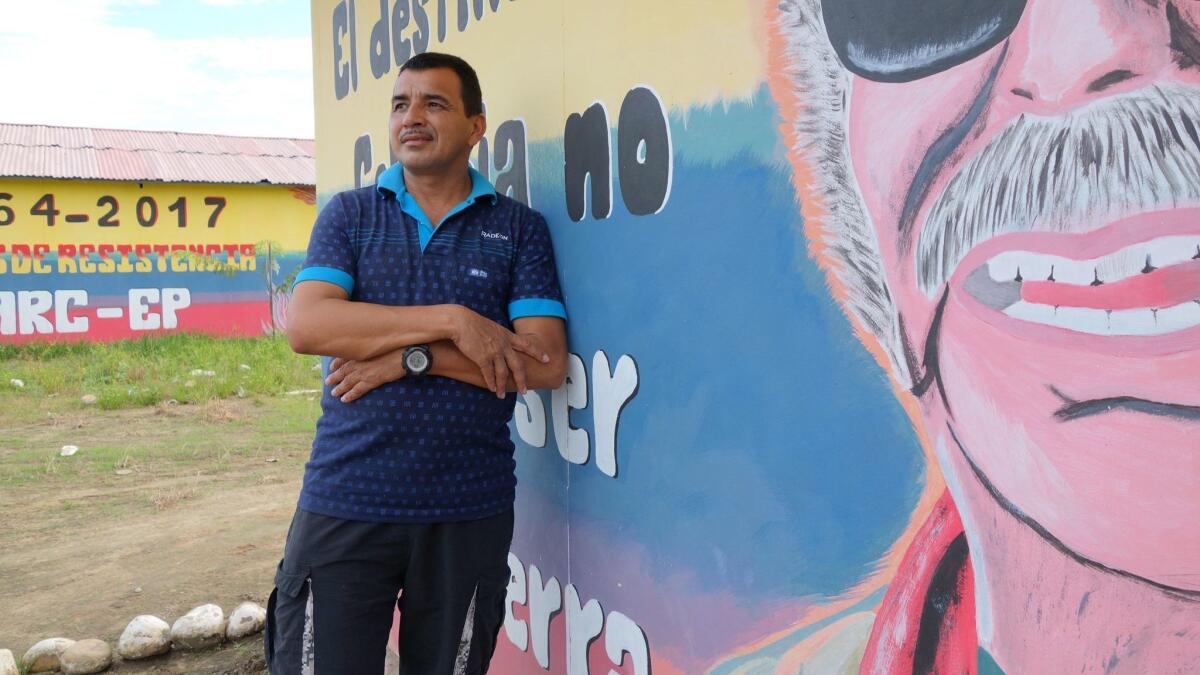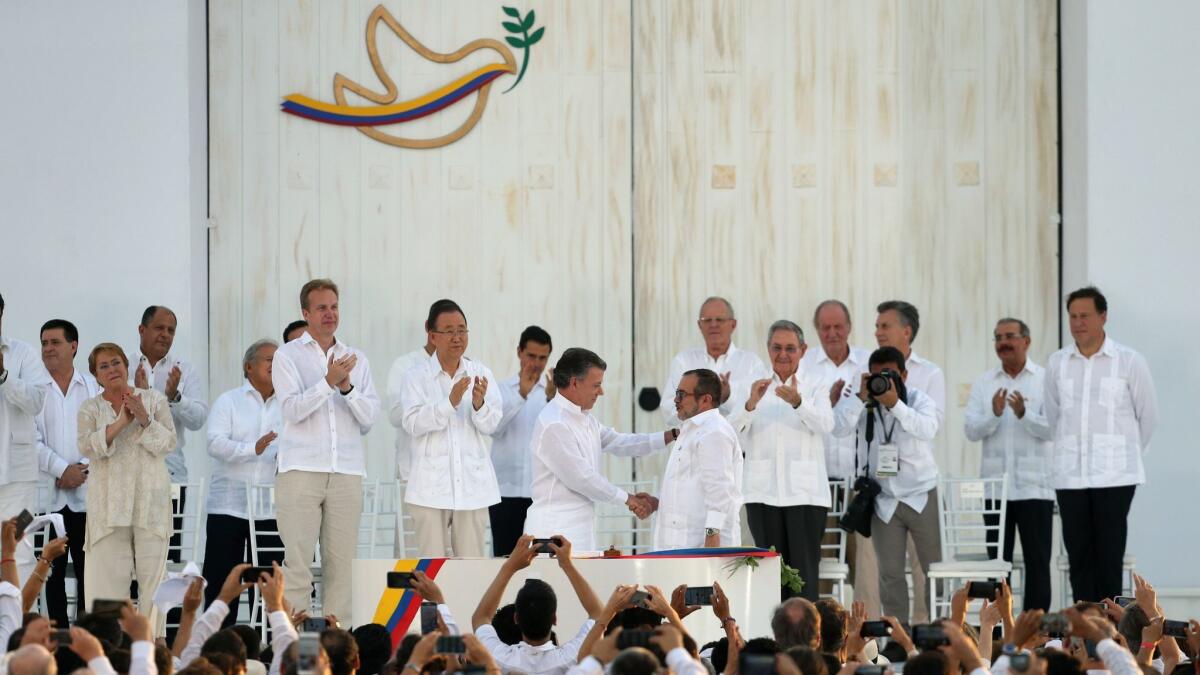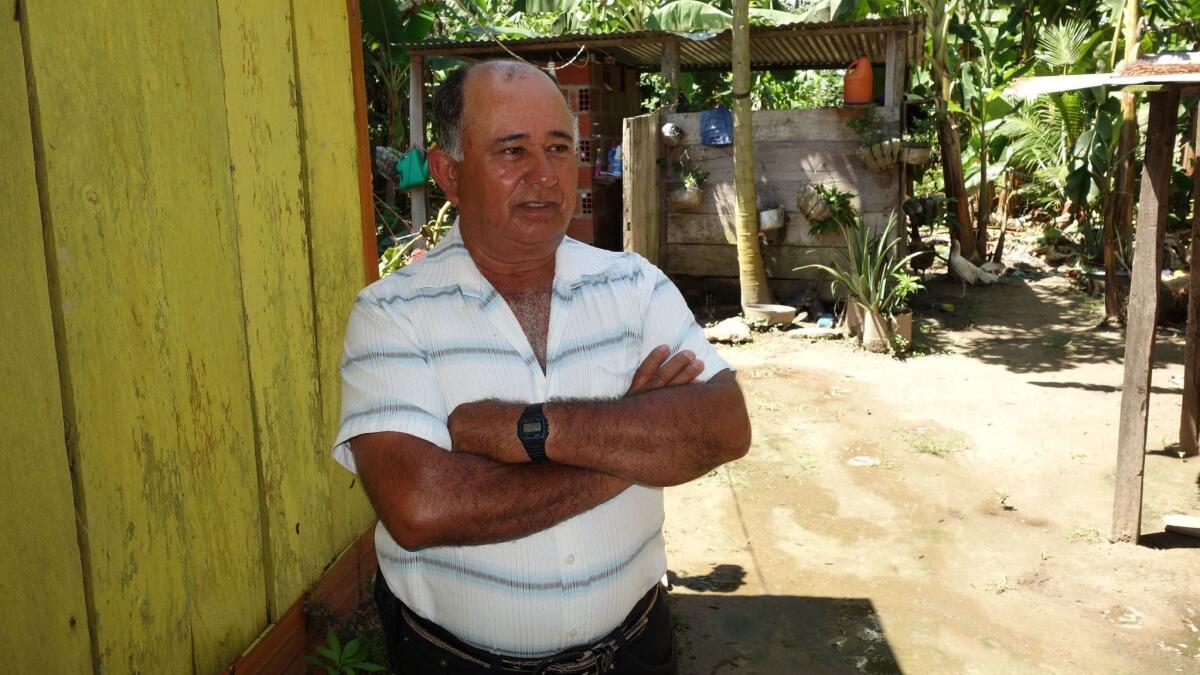Killings of demobilized rebels threaten peace process in Colombia

- Share via
Reporting from Filipinas, Colombia — After more than 20 years as a guerrilla — the last five in prison after being wounded and captured — Juan Vicente Carvajal wanted to start life over.
Freed last year under the peace agreement that ended five decades of civil war between the government and his rebel group, the Revolutionary Armed Forces of Colombia, or FARC, he moved to this village of about 500 people where his sister owns a grocery store.
He bought a 90-acre farm outside town with a loan from his brother, planted plantain, corn and manioc, and started building a house. He also joined the local village council that settles property disputes and identifies needed public works projects. At 41, he was newly married.
“He wanted to become a totally different man,” said his sister, Luz Maribel Carvajal. “He didn’t want to hear about arms, guerrillas, fighting, anything like that, because he had suffered for 24 years and didn’t want that life or to be reminded of it.”
But his past proved inescapable. In the early evening of May 7, he was riding his motorcycle from his farm to the village when somebody shot him six times with a high-caliber rifle.
He died on the spot from massive head wounds — one of 64 former combatants killed since the signing of the peace agreement in November 2016. The FARC, which has handed over its arms in a transformation from guerrilla movement to political party, says that 17 relatives of ex-rebels have also been slain.
The pace of killings appears to be accelerating, with three ex-fighters gunned down in four days at the end of May in separate incidents in southwestern Colombia.
The slayings have shaken faith in an already fragile peace process.
Colombia’s civil war left 220,000 people dead and 7 million displaced. The peace deal — for which President Juan Manuel Santos was awarded the Nobel Peace Prize — guarantees the former rebels representation in Congress, economic aid and minimal punishments for war crimes. Many Colombians consider that too generous and have thrown their support behind presidential candidate Ivan Duque, who has helped establish himself as the front-runner in the election scheduled this month by promising to require former rebels to serve prison sentences for certain crimes.
All of the homicides have taken place outside the 26 reintegration camps where the guerrillas went to disarm and receive vocational training and counseling — and where hundreds of government soldiers protect the considerable numbers who remain. Still, trust between the two sides has withered.
“The killings are creating anxiety among ex-FARC fighters, especially when added to delays in economic aid and the hardening political climate,” said Andres Cajiao, an investigator with Ideas for Peace Foundation, a civil society group based in the capital, Bogota. “The deaths are generating more and more distrust toward the government.”
Brig. Gen Alvaro Perez, an army commander based in Arauca, the province where Carvajal was killed, said that as many as 1,200 former rebels — or 1 out of every 6 who demobilized — have regrouped across Colombia into so-called dissident FARC units and started raising money to rearm.
Adam Isacson, a senior fellow at the Washington Office on Latin America think tank, said many more could follow “if killings of ex-FARC members escalate.”
The future of the peace process could hinge on whether the government can “quickly identify and punish those behind at least some of the killings,” he said.

That hasn’t happened. The attorney general’s office was unable to point to any arrests, though a spokeswoman said that warrants have been issued in nine of the 22 killings between January and early May.
Of those nine killings, four were committed by another rebel group known as the National Liberation Army, which was not part of the peace agreement, two were the work of FARC fighters who took up arms again or never relinquished them, and one had nothing to do with “armed groups,” according to a statement from the attorney general. It did not address the remaining two deaths.
The United Nations said in a report last month that the killings of former rebels and their families were mostly attributable to those same armed groups as well as a drug trafficking gang known as the Clan del Golfo.
It’s unclear who killed Carvajal, but he had many years to make various enemies. He joined the rebels in 1994 at the age of 17 because — as his sister explained — he wanted to stop paramilitary groups that were working on behalf of land grabbers and displacing poor people.
Under the nom de guerre Misael, he eventually rose to second in command of the rebels’ 10th Front, which operated in his home province of Arauca in eastern Colombia. It was one of the bloodiest battle zones of the civil war. He directed offensives against the army and collected extortion payments from farmers, cattle ranchers, store owners and oil field services firms that flocked to Arauca province after oil was discovered there in the early 1980s.
With the government weak or nonexistent in certain rural areas, he also oversaw efforts by FARC to administer justice against alleged thieves, killers, rapists or even young fathers who failed to help care for their children.
In 2012, he was shot and seriously wounded in a battle with army troops, which led to his arrest and conviction on charges of rebellion.
When he was released from Bogota’s maximum security La Picota prison in July, the government gave him its standard cautionary advice for demobilized rebels: Don’t resettle where you fought.
Carvajal ignored it. He wanted to be near his family.
One of the reintegration camps, Martin Villa Training and Reincorporation Territorial Space, sits just outside Filipinas and houses 365 people.
But Carvajal turned down the chance to live there. He wanted to speed up his transition to civilian life.
A special government unit offered protection to ex-combatants who requested it. Carvajal never asked. In the days leading up to his killing, friends and family said, he hadn’t mentioned any threats.

He was well liked around Filipinas, said Juan Pablo Aguirre, a farmer and director of the village council on which Carvajal served. During the war, Carvajal had earned a reputation among the locals as a fair-minded commander who cared about the community and used his authority to force construction companies to build roads so farmers could more easily transport their crops to market.
That popularity may have given him a false sense of security as a civilian, Aguirre said.
Nelson Quintero, a friend and former rebel comrade who is a leader at the nearby camp, said Carvajal took his safety for granted.
“He didn’t understand,” Quintero said. “He thought of this as his pueblo, his community. We told him, ‘Come and stay here, where there is a little security.’
“But no, he wanted to stay in Filipinas with his sister. So every day everyone saw him enter and leave his farm on his motorcycle. And he ended up getting killed.”
The day after the slaying, Rodrigo Londono — who had been the FARC’s supreme commander during the war and presidential candidate before dropping out of the race in March amid constant harassment at his campaign rallies — issued a statement reminding ex-combatants not to let their guard down.
He suggested that Carvajal may have acted carelessly in an area where he “had played a leading role in conflicts … and which opened so many wounds.”
“The conflict has not finished,” he wrote. “It’s only changed its form of expression, which requires consistent behavior from us. Our strength resides in acting collectively, we can’t forget that.”
In an interview, Arauca’s governor, Ricardo Alvarado, blamed the killing on “dark forces” trying to undermine the peace accord to prevent land they had acquired illegally during the war from being returned to its rightful owners.
“There is evidence that I can’t discuss because the investigation is still ongoing that suggests that the people who are responsible come from economic forces who got rich from the war and want it to keep going,” he said. “These are criminal groups interested in destabilization.”
The killing has shaken the community around Filipinas.
“He was a man who was interested in peace and development,” Aguirre said. “He was confident about the future and set a good example. There was not a hint of paramilitary activity before this. Now as a community leader, I don’t feel secure.”
Immediately after the killing, the army increased the number of soldiers deployed to the Filipinas area to 600 from 400 in an effort to bolster security for the former rebels, according to Perez, the army commander based in Arauca.
“The army is the most interested party in guaranteeing that security works,” he said. “We were enemies. We suffered many deaths in this war. It’s not an easy process for us but we intend to comply with this task.
“Peace will be a 10-year process and we are only 20% into it,” he said.
Even with more armed guards, ex-fighters at the demobilization camp said they no longer feel safe.
“People here are discouraged,” Quintero said. “The good faith is ending.”
Disillusioned with the peace accord, about 60 former rebels have joined dissident FARC units in Arauca and begun blocking roads and extorting money from businesses for arms and uniforms, according to officials.
The dissidents are already seizing on the killing of Carvajal to help make their case for more war.
In an “open letter to ex-combatants,” they blamed the “cowardly” homicide on the Colombian army and the paramilitaries and said it was part of “a plan of extermination that the state has launched because of the failure of the misnamed peace process.”
The leaflets, which were left at a roadblock, called on demobilized FARC fighters “tricked by the peace agreement” to take up arms with them.
Kraul is a special correspondent.
More to Read
Sign up for Essential California
The most important California stories and recommendations in your inbox every morning.
You may occasionally receive promotional content from the Los Angeles Times.










